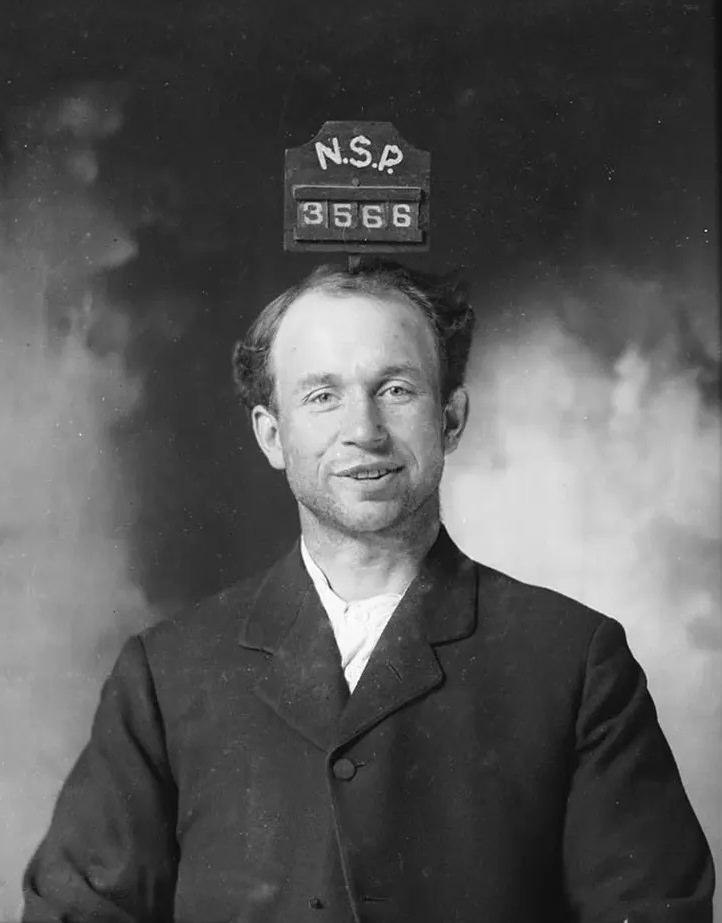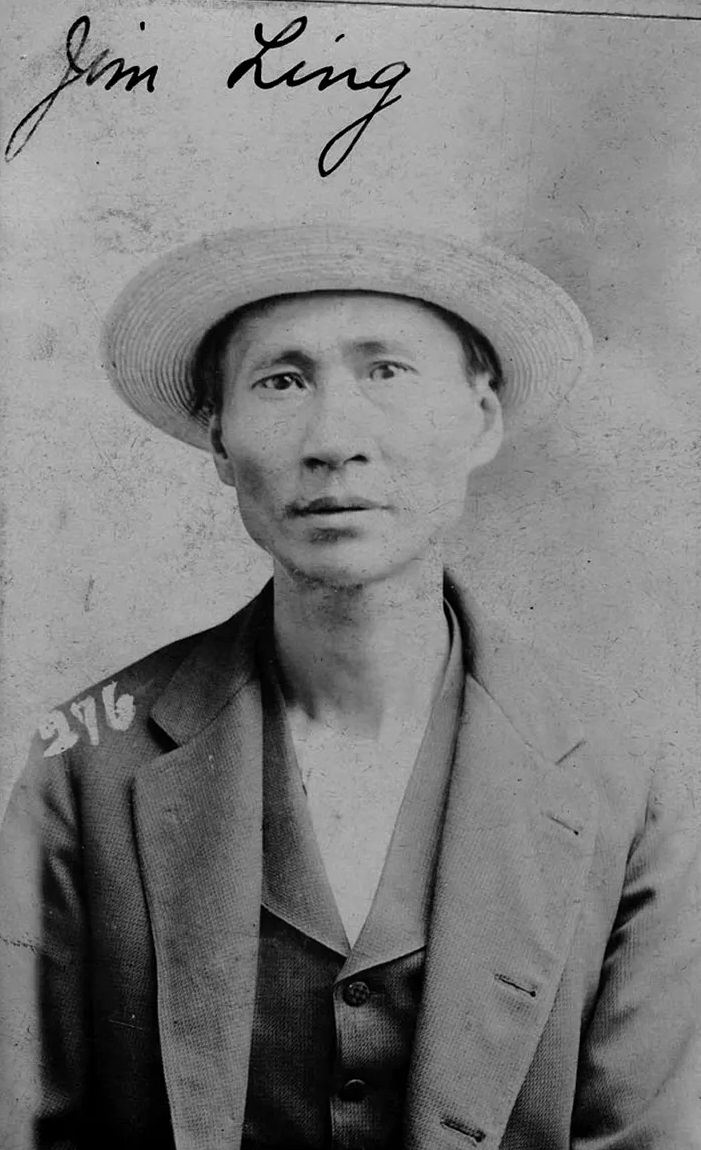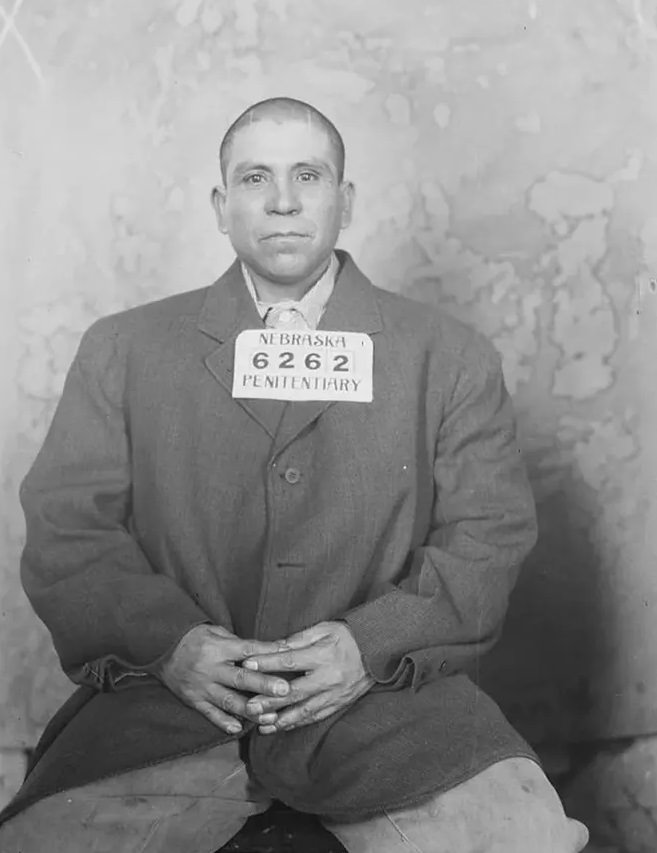A significant revolution in crime investigations occurred when mug shots were introduced. It enabled the police to keep visual records of the criminals they arrested.
The police began photographing criminals’ faces in the mid-1800s. Known as “mug shots” (after the British slang word “mug” meaning “face”), these images replaced drawings and descriptions on wanted posters. Researchers even studied mug shots to determine how physical traits predicted criminal behavior. Those convicted were photographed after their hair and beards were shaved off to prevent lice from spreading.
In 1867, the Nebraska State Penitentiary began photographing the state’s most notorious inmates. When suspects were arrested, the Omaha police took photographs. Whether the people depicted were innocent or guilty, every photograph told a story. Photographs from the Nebraska State Penitentiary and Omaha Police Court Collections offer a glimpse into the lives of some random people more than 130 years ago. Several of the offenders in these mug shots were arrested for “grand larceny”. In the U.S., larceny refers to pickpocketing. Larceny “from a person” is considered a crime of deprivation of property. There is also the term “mayhem,” which refers to the permanent disfigurement or disability of another.
#1 James Whitewater
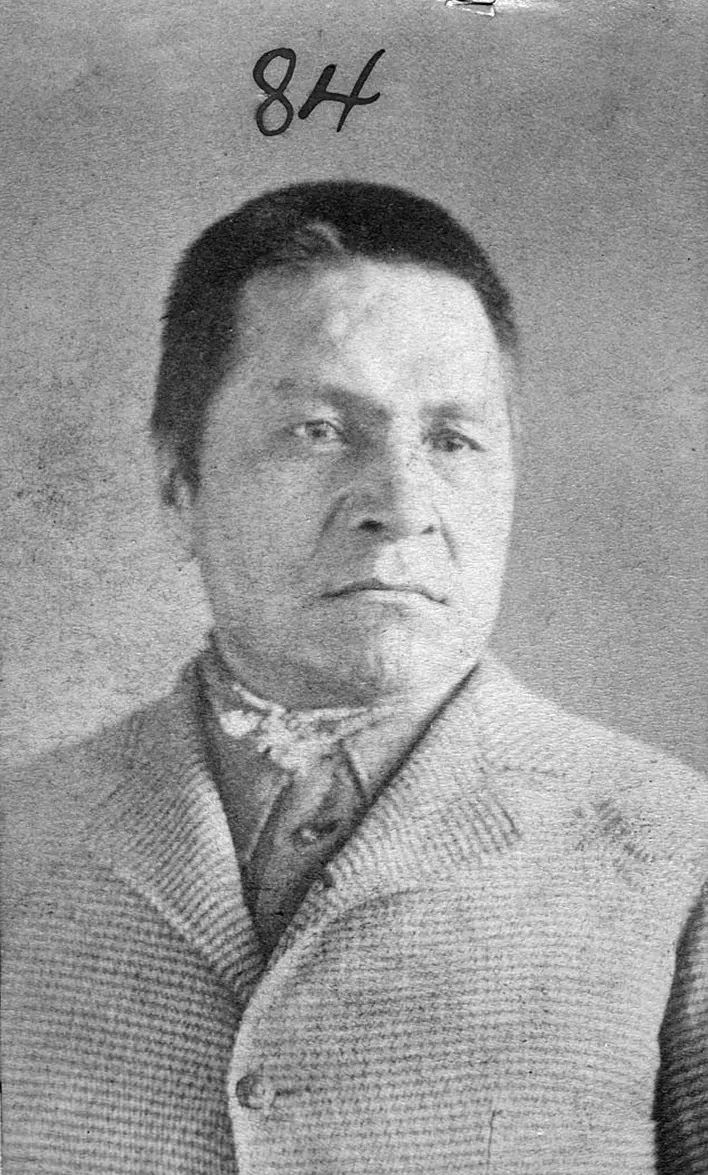
James Whitewater murdered two men. During his imprisonment from 1872-1889, he became a Christian. Nebraska passed an act in 1889 that allowed the governor to pardon two inmates who had "served more than 10 years in prison or whose behavior while incarcerated merited such mercy."
#2 Albert Johnson.
#3 Albert Johnson shaved.
#4 George H. Ray.
#5 James Collins.
#6 Goldie Williams.

When Goldie Williams was photographed for her Omaha Police Court mug shot, she crossed her arms defiantly. She was arrested for vagrancy on Jan. 29, 1898. She stood only five feet tall and weighed 110 pounds. She listed her home as Chicago. Her left index finger was broken, and she had a cut below her right wrist, according to her arrest description. Williams wears a hat with satin ribbons and feathers. Additionally, she wears large hoop earrings.
#7 Charles Martin.

On the night of Feb. 15, 1898, three burglars blew up a safe in a bank vault in Sheridan, Missouri. They got away with about $2,400. In order to track down the burglars, the bank's insurance company hired Pinkerton Detective Agency and Assistant Superintendent F.H. Tollotson. Eventually, Tollotson found one of the wanted men in the Sheridan Hotel in Omaha after tracking him through Missouri and Council Bluffs. After a brief struggle, Tollotson apprehended a gun-welding fugitive with the help of Omaha police. There were several letters addressed to Charles Davis addressed to the alleged bank robber, Charles Martin. Some detectives speculated to newspaper reporters that Martin might be the notorious safe blower and bank robber Sam Welsh. His share of the Missouri bank robbery spoils included a gold watch and $565 in cash at the time of his arrest. Martin was taken to the police court where he was measured, photographed and locked up while he awaited his transfer to Missouri.
#8 Jim Ling
#9 Herbert Cockran.

Herbert Cockran is held in a headlock by an unidentified Omaha police officer during his mug shot. Cockran was arrested on Nov. 24, 1899, for burglary. According to the police description, Cockran was a tailor from Fairmont, Nebraska, with a slightly stooped build and a fair complexion.
#10 Frank L. Dinsmore.

The tiny town of Odessa, Buffalo County, was rocked by a double murder on Dec. 4, 1899. Lillian Dinsmore was found dead in the kitchen of the house where she and her charismatic husband lived. The boarding house owner, Fred Laue, was shot in his bedroom. The Dinsmores had been married only a year. Fred Laue's wife claims that Mr. Dinsmore became obsessed with her and seduced her. Dinsmore allegedly plotted to kill his young wife and Laue because he was unhappy in his marriage. Lillian Dinsmore's brothers accused Dinsmore of hypnotizing their sister after she was murdered. Mrs. Laue also claimed to have been hypnotized by Dinsmore after hearing the accusation. Newspapers became enthralled with the Dinsmore case. He vehemently denied all the charges despite the guilty verdict, and he was executed by hanging. Governor Dietrich commuted Dinsmore's sentence to life in prison after his lawyers appealed the sentence. He wore a white cotton shirt, a sack jacket and striped pants issued to prisoners at the Nebraska State Prison for his mug shot.
#11 Mrs. Adams.
#12 Bert Martin.

Bert Martin was sentenced for stealing a horse from Keya Paha County. Bert worked in the broom factory at the prison. One day, Bert's cellmate of 11 months revealed a secret: Bert was really a woman named Lena Martin. Lena's masculine appearance allowed her to find work as a cowboy in sparsely populated Keya Paha County. On Sept. 22, 1901, Martin was transferred to the women's division. During Martin's sentencing, a woman, believed to be his wife, stood beside him. Martin was sentenced to two years. The Governor of Nebraska Ezra P. Savage said of her: “a sexual monstrosity, unfit for association with men or women even in a penal institution, and on the solemn promise of its aging mother to care for it and guard it, and because prison morals imperatively demanded its removal, the sentence was commuted to one year, six months, February 3, 1902.”
#13 Nora Courier.
#14 Robinson.
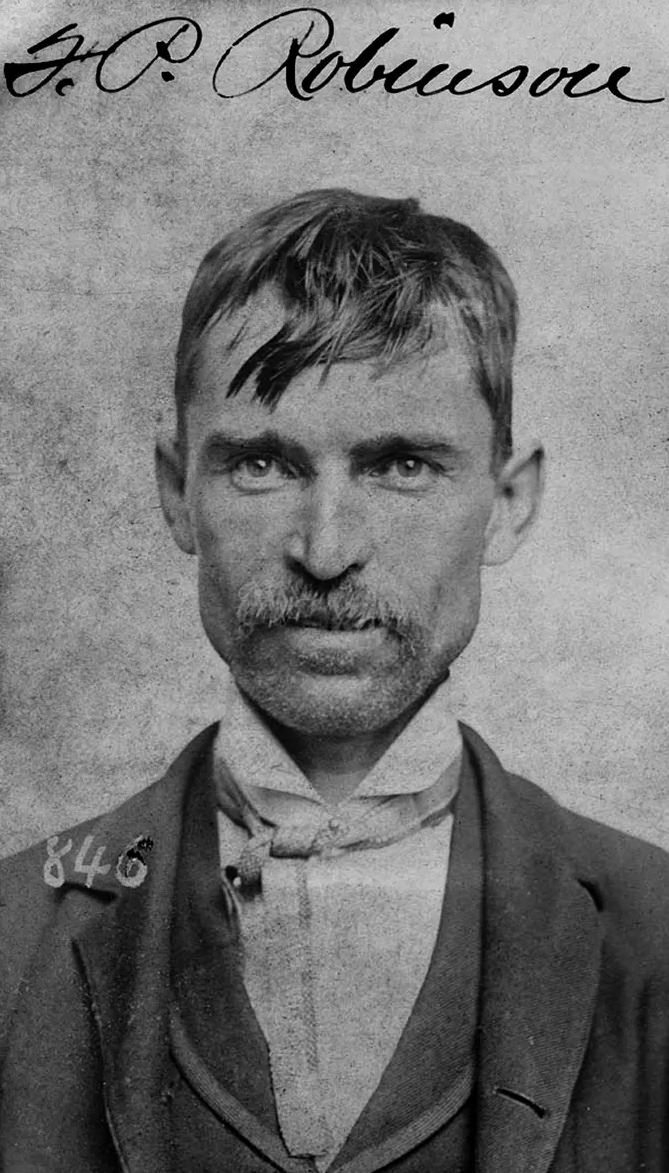
On Nov. 21, 1901, Robinson paid for a glass of beer with a Mexican dollar in a lower Douglas Street saloon. The beer cost only a nickel and Robinson received 95 cents of American money in change. Foreign currencies were almost identical to American currencies at the time, but were only worth about 45 cents. A clever money scam left Robinson 50 cents and a glass of lager ahead until he was arrested.
#15 George Leonard.
#16 Minnie Bradley.
#17 Bertha Liebbeke.

Bertha Liebbeke gained a reputation as one of the Midwest's most notorious pickpockets. She would look for a well-dressed man with a diamond lapel pin. She would then "accidentally" stumble into the helpless victim, pretending to faint. In an attempt to help her, Bertha would strip the gentleman of his valuables or wallet. She earned the nickname "Fainting Bertha." Authorities from Illinois, Kansas, Iowa, Missouri and Nebraska knew her tricks. The mug shot of Bertha Siegel in the Omaha Police Court listed her aliases as Bertha Liebke, Jennie Jennings, Bertha Nixon, J. Armstrong, Carrie Jones, Bessie Milles, Menni Swilson, and Bertha Siegel.
#18 Charles Hutchinson.

Eli Feasel went missing from his farm southwest of Bostwick, Nebraska, about 15 miles east of Red Cloud, on Nov. 1, 1903. His housekeeper, Nannie Hutchinson, said he visited his son in Kansas City. Eli Feasel's brother, Thomas, became suspicious when he could not locate Eli. Charles, 21 years old, and his mother, the housekeeper, were arrested after the investigation was conducted. The two were released after their hearing after little evidence was found that a crime had been committed. Charles Hutchinson was believed to have seen Mr. Stanley plowing the field where the grave was later discovered. Charles began to act suspiciously. He rented a buggy on May 6. He said he would assist in taking the rig to Starke Ranch at Amboy, about five miles east. In the morning, Charles returned the rig to Red Cloud and paid Amboy the usual fee. The horses used by Charles had a longer drive than a trip to Amboy. There was also a terrible stench emanating from the rented buggy and cushions. They paid little attention to it until Mr. Stanley discovered the open grave in Eli Feasel’s place. Charles and Nannie were quickly rearrested when authorities became aware of the new evidence. According to authorities, Charles and his mother returned to the site where they had hidden Feasel's body on the night they rented the buggy to move the remains. They had left behind telltale clues: footprints matching the shoe sizes of a man and woman. The Hutchinsons were found guilty of second-degree murder at trial.
#19 Nannie Hutchinson.
#20 John Reid.

The African American members of Troop B, Tenth United States Cavalry Regiment, and Crawford, Nebraska, engaged in a violent confrontation on May 13, 1906. Crawford Marshal Arthur Moss and Sergeant John Reid of Troop B had almost fought after a horse race a year before. The animosity between the two men continued. On the evening of May 13, Moss was sent to break up a soldier’s beer party near the city park on the west edge of town. The party was ordered to quiet down or disperse by Moss. An altercation broke out between Moss, Reid and Pvt. Jordan Taylor, also from Troop B. During the brief scuffle, Reid shot Moss with a .38-caliber revolver. Reid and Taylor fled into town and took refuge at the home of Edna Ewing, an elder black resident. Several civilians fired upon the soldiers as they made their escape. Art Moss died shortly after being shot. Taylor bolted from the Ewing house as a crowd gathered and ran toward Fort Robinson. Before getting very far, he was fatally wounded. Reid was captured and taken under guard to the city jail. Crawford was abuzz with rumors that Fort Robinson soldiers had threatened to storm the jail and free Reid. Prison officials feared the prisoner would be lynched by a civilian mob. So, they decided to move Reid to the Chadron jail for safety. Several men and rifles from Troop B went missing before he could be transported from the fort. Colonel Augur quickly sent Troops I and K into town to prevent further violence. Soldier guards surrounded the jail. The tensions persisted into the next day. Seven men reported absent from the B Troop barracks were placed in the post guardhouse, and 14 rifles were found in the town. Reid was transferred to the Chadron jail. In the end, he was convicted of manslaughter and sentenced to seven years in Nebraska State Prison for the death of Arthur Moss.
#21 Alberto Interciago.

In February 1914, Alberto Interciago was sentenced to one to 20 years in Nebraska State Prison for "assault to wound". During the Mexican Revolution, 1910-1920, rebel leaders Emiliano Zapata and Pancho Villa popularized thick mustaches. In the second set of mug shots, Interciago's hair and mustache have been shaved.
#22 Alberto Interciago
#23 Jennie Lester.
#24 Thomas Whitney.

Known as The Professor by his clients, Thomas Whitney advertised extensively as a clairvoyant, palmist, and astrologer in Omaha newspapers. Whitney claimed he had no equal in giving advice on love, law, deeds, wills, mining, divorce, changes, investments, patents and all other business of a financial nature. Gentlemen pay $1 and ladies pay $.50 for readings. During December 1915, The Professor was arrested for obtaining money under false pretenses from one of his customers.
#25 Shock.
#26 Mattie Brown
#27 William H. Lee.

On May 1, 1917, Nebraska's prohibition law went into effect, prohibiting liquor manufacture and sale. After that, Nebraska jails began to fill with people violating liquor laws. In December 1919, William H. Lee was sentenced to six months to two years in the Nebraska State Prison for bootlegging in Hitchcock County. The illegal transportation of alcoholic beverages is known as bootlegging. Lee was granted a furlough by prison authorities to visit his terminally ill wife. He returned to prison and was released on July 4, 1921.
#28 Lola Lopez.
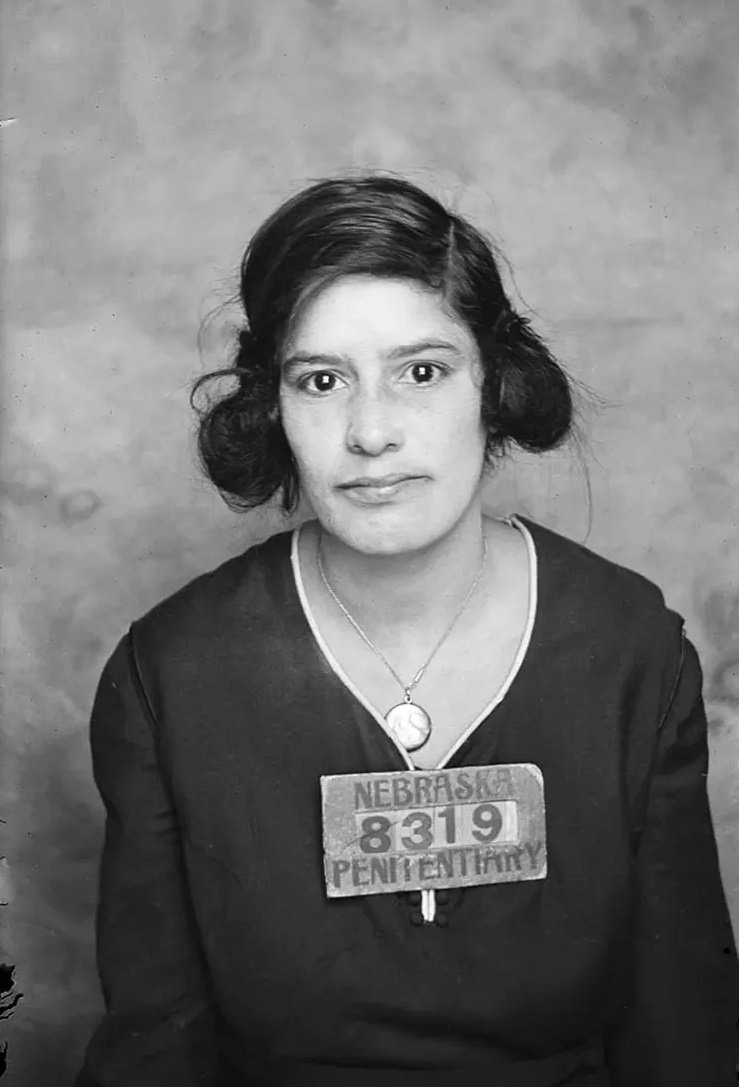
The mug shot of Lola Lopez in Nebraska State Prison shows her wearing a large gold locket. On Jan. 9, 1922, her companion Cicerio Estrada clubbed, strangled, and robbed Stephen Pann in the Null Rooming House in Sidney, Nebraska. Estrada and Lopez fled hours before the murder was discovered. They were captured in Greeley, Colorado, and returned to Sidney for trial. Lopez, who was Mexican-born, pleaded not guilty but admitted knowledge of the murder through an interpreter. Two years, two months, and 22 days were served by her.
#29 Mary Shannon.
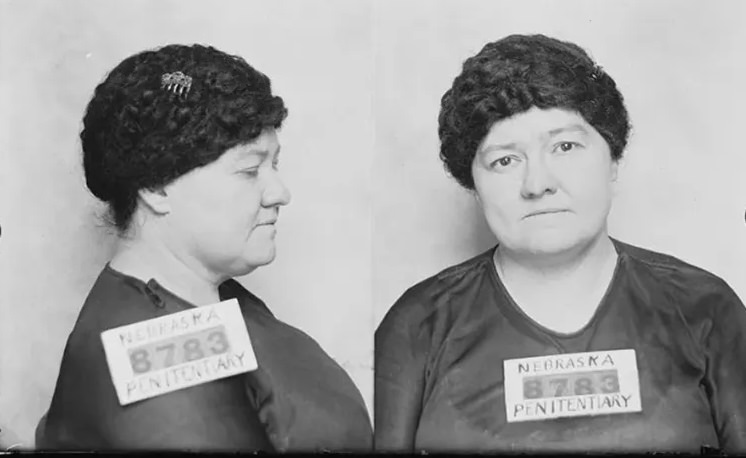
Mary Shannon was sentenced to two years in the Nebraska State Prison for mayhem in May 1925. There is no explanation in her records as to why she was charged with mayhem. Legally, mayhem is the act of disabling, disfiguring, or cutting off or rendering useless one of another's members (leg, arm, hand, foot, eye) either intentionally or in a fight. Mayhem is classified as an aggravated assault in most states due to the serious nature of the injury.
#30 Frank Carter.

Frank Carter, also known as the Omaha Sniper, terrorized Omaha in February 1926. He shot people at random, sometimes using a silencer on his pistol. People were shot as they stood at their lighted windows, according to Omaha newspapers. Carter brought Omaha to a standstill, with empty streets, for over a week. He was captured on Feb. 26 and tried for murdering two people, but he said he killed 43. Despite his lawyers' attempts to plead insanity, he was found guilty and electrocuted in June 1927. According to reports, Carter's last words were "let the juice flow."
#31 Jake Vohland.

Jake Vohland attempted to steal chickens from Mr. and Mrs. Stubblefield. To protect their large chicken farm in Gibbon, the Stubblefields developed an ingenious homemade burglar alarm. They placed a mousetrap near the chicken barn door that rang bells in their living room and bedroom. During a dark night in March 1931, Vohland unknowingly triggered the burglar alarm. The alleged thief ran out of the chicken house refusing to stop when Mr. Stubblefield cried halt. While fleeing, the alleged thief dropped part of his booty and managed to escape with only 10 chickens worth over $5. In his haste, the burglar did not stop for his car and made his getaway on foot. Mr. Stubblefield notified the sheriff after parking near the abandoned car. The sheriff quickly determined the car belonged to Vohland and proceeded to his home. Even though Vohland claimed the car had been stolen for the chicken house raid, he was arrested. The jury did not believe Vohland’s story. Nebraska State Prison sentenced him to one year in prison for theft.
#32 James Pappas.
#33 Alv Lytle.

Alv Lytle, the man pictured here with a shaved head, was convicted of bank robbery in Kearney County, Nebraska and sentenced to 12-15 years in the Nebraska State Prison. The state paid Lytle $2,500 for false imprisonment after another man confessed to the crime. For a crime he did not commit, he served two years and seven days in prison.
#34 Ruby Fox.

Ruby Fox and Myrtle Hetrick met while incarcerated at the State Reformatory for Women in York, Nebraska. Ruby was serving time for breaking and entering, and Myrtle for vagrancy. Ruby and Myrtle, unhappy with their treatment, devised an escape plan. The two women fled Nebraska in an automobile with the help of an unidentified man. The fugitives were captured in Casper, Wyoming. When they returned to Nebraska, Ruby and Myrtle requested to go to the Nebraska State Prison instead of the York reformatory. Their escape resulted in a one-year sentence at the Nebraska State Prison.
#35 Myrtle Hetrick.

Myrtle Hetrick met with Ruby while incarcerated at the State Reformatory for Women in York, Nebraska. Ruby was serving time for breaking and entering, and Myrtle for vagrancy. Ruby and Myrtle, unhappy with their treatment, devised an escape plan. The two women fled Nebraska in an automobile with the help of an unidentified man. The fugitives were captured in Casper, Wyoming. When they returned to Nebraska, Ruby and Myrtle requested to go to the Nebraska State Prison instead of the York reformatory. Their escape resulted in a one-year sentence at the Nebraska State Prison.




